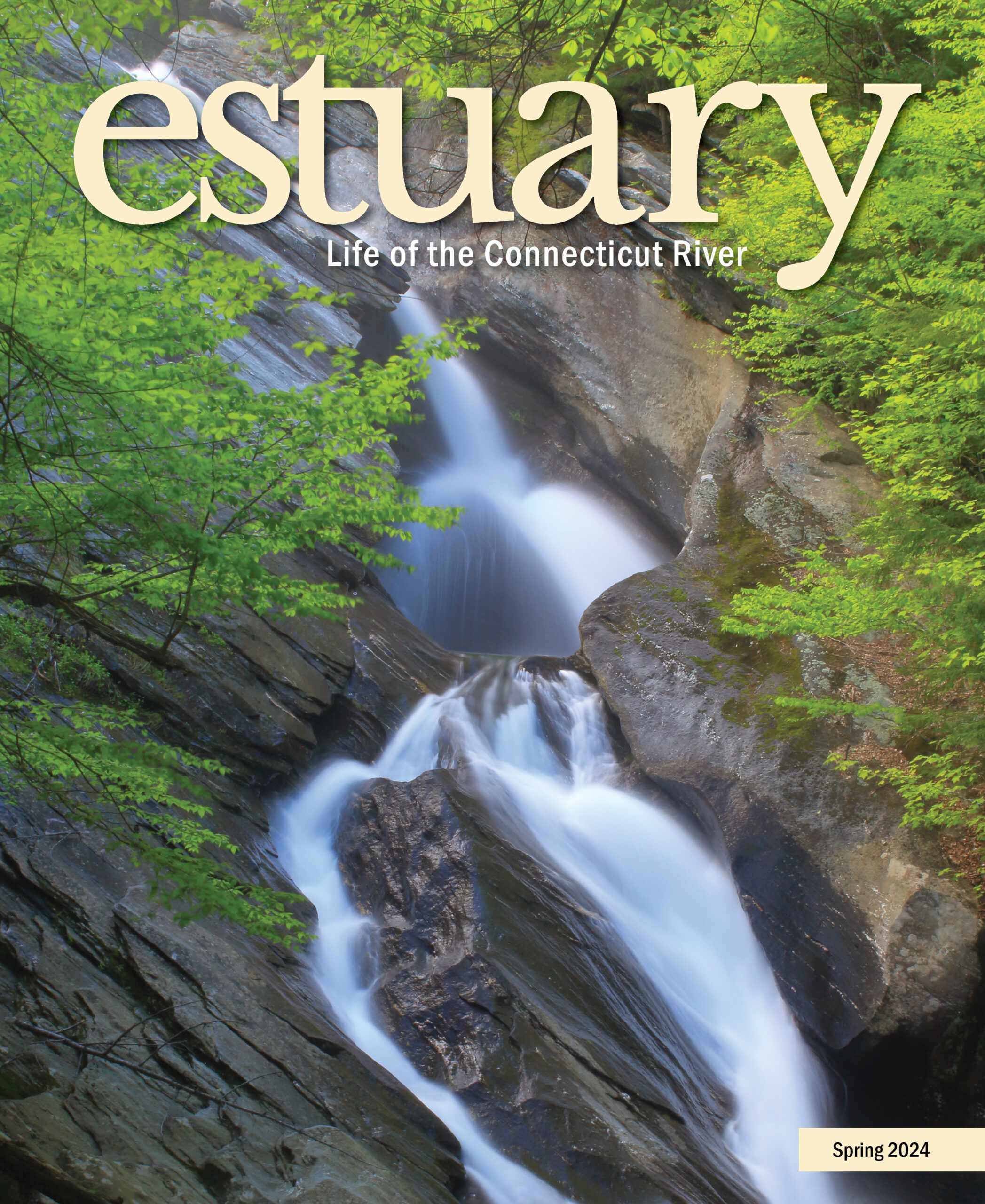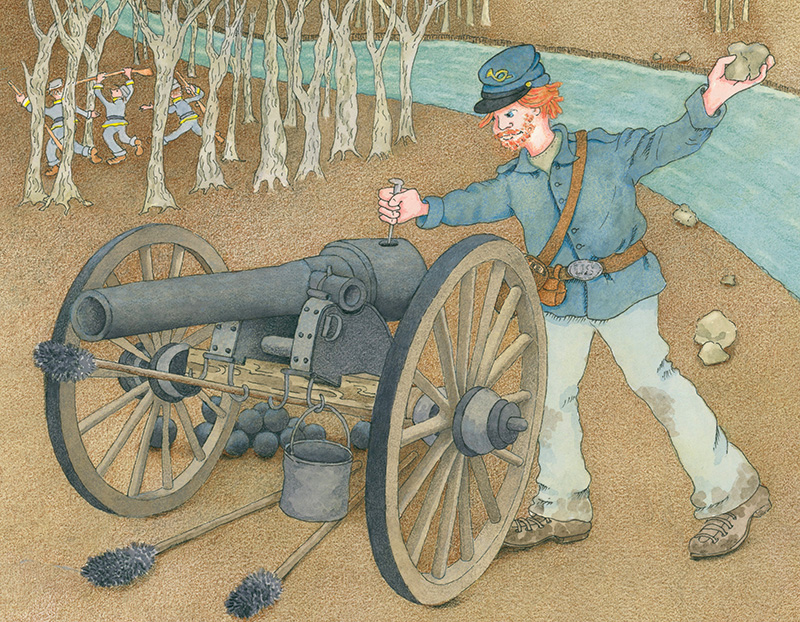 This article appears in the Spring 2024 issue
This article appears in the Spring 2024 issue

Chapter 13: Crossing the Rappahannock
“So, how?” Lieutenant Dunbar said, arms folded, eyes squinted, staring out across the Rappahannock River. “The cavalry could just charge across the river at Kelly’s Ford, but they’d get blown out of the water by those three cannons. The Rebels destroyed the only two actual bridges. Well, bridge or no bridge, we must cross this river and disarm those cannons. It’s our job to make it safe for the cavalry.”
I stepped forward and said, “I know how to make a kind of bridge, Sir.”
The Lieutenant turned to face me. “Ok, JJ. I’m listening.”
“I saw several flat-bottom skiffs, Sir, on a boat rack behind that old Post Office. We could use them as a base for a pontoon bridge.”
“A pontoon bridge,” the Lieutenant said. “That could work. If we can get across the river, surprise the Rebels, and drive them back, we might just have enough time to spike those cannons.”
“Sir? Spike?”
“Drive a spike, a nail, a bayonet blade into the touchhole, knock the nail-head off, and that cannon won’t be firing at anything or anybody any time soon.”

And so, the Lieutenant formulated a plan right there on the spot, talking out loud, not to us so much as to himself. My dad thinks out loud like that all the time, which is why I knew to stay quiet and not interrupt or try to say something or ask a question while the Lieutenant was working things out with all of us listening in.
He reasoned we should move upriver far enough away from Kelly’s Ford to avoid the cannons, but not so far that we might attract the attention of that Rebel camp near the fort. The few soldiers stationed at the cannons were camping without tents.
“Fall in,” the Lieutenant said after a short time. “I have a plan. We will build the pontoon bridge, cross to their side, and spike those cannons. I want you to shoot, not to kill, but over their heads. We must not invite a gun battle, which might cost us time and casualties.”

The Lieutenant divided our unit in half, one group he ordered to build the pontoon bridge—me and seven other soldiers—and the others to stand guard in the trees, keeping an eye on the Rebel side of the river for enemy movement and to provide cover for those of us working out in the river like sitting ducks.
I volunteered to be the one to swim across the river and secure the anchor line. We waited to make our move until we saw the first star appear next to a mere sliver of a moon in the dark night sky. Under the cover of darkness and with the whole night ahead of us, we got to work.
While the rest of my unit carried the skiffs from the boat racks and lined them up along the river’s edge, I stripped down to my long johns. Lieutenant Dunbar tied one end of a very long rope around the bottom of a tree nearest the north bank of the river then positioned himself next to some shrubbery on the riverbank with a whole lot of extra rope coiled at his side. I tied the other end of that rope around my upper chest and waded into the river.
Even though the night was warm, a cold chill ran up my spine at the shock of the water rushing around my legs. I shifted my weight, leaned into the water, and one step at a time, moved out into the river. I felt Lieutenant Dunbar tug at the rope and knew he’d reel me in if I started to get dragged away by the current.
About fifty feet into the river, the bottom dropped away, and I felt the much colder, deeper, water swirling around my feet and legs. Ahead of me was darkness. I thought I could see water eddying around a bit of debris, a tree limb maybe, sticking out of the water maybe fifteen feet ahead of me. I kicked and stroked, throwing my right arm out ahead of me, pulling the water back, then my left arm, then the right again and the left until I felt the wet bark of a tree limb under my left hand. I grabbed it, pulled myself forward, and lodged my body against the upstream side of the limb. I stopped only long enough to catch my breath, then plunged forward and swam the rest of the way to the other bank.
As soon as I reached the other side I climbed up onto the bank. Now in Rebel territory I ducked down and moved around the outside edge of an abatis to what the Lieutenant had reasoned would be a good anchor tree. I pulled at the rope until it was almost taut but loose enough to relax onto the surface of the water. I wrapped the rope around the base of that tree several times, tied it off with good, strong knots and camouflaged the rope as best I could with some nearby brush.
When I heard a single gunshot I jumped, crouched down, and ran as fast as I could, easing back into the river. I grabbed hold of the anchor rope and, moving hand-over-hand, pulled myself back across the river. I pulled myself up onto the bank and ran past the guards and into the trees.
“This is taking longer than I had hoped,” the Lieutenant said. “I’d feel a whole lot better if the Rebels weren’t firing off a shot every now and then, but at what?” He shook his head, then answered his own question. “Probably shooting at night critters like raccoons, or opossum.”

The anchor line in place, the skiffs lined up along the bank upstream, we were ready to begin. What a sight we were, eight of us, stripped down to our long johns, ready to build a pontoon bridge. I jumped into the first skiff in the line-up and grabbed hold of the oars. Lieutenant Dunbar gave me a good shove launching me into the river while the rest of the troop got ready to launch. Lieutenant Dunbar pushed each one of the skiffs into the water until all eight were easing silently down the river, ghostly black shapes floating along in the black water.
Using hand signals and working in silence, we secured the square stern of each boat to the anchor rope, leaving about four feet of space in between skiffs.
When all eight skiffs were secured to the anchor rope, we each eased into the water, grabbed the anchor line, and made our way back to the bank on the north side. We reconnoitered with the Lieutenant in the trees where I got back into my uniform while the Lieutenant laid out the rest of the plan.
“Sunrise will be around 5:30,” the Lieutenant said. “That leaves four hours to secure enough planks across those skiffs for our unit to cross. If this works, we’ll be able to spike those cannons.”

We set the planks in place, from one riverbank to the other, but we didn’t have enough time to secure them all to the skiffs—they looked great, but most weren’t held in place by anything but our imaginations.
Four-thirty, not yet first light, our rifles armed, we jogged across our shaky pontoon bridge, single file. We amassed on the Rebel side, ran about fifty yards toward the three cannons. We stormed in, shouting, screaming, and firing up into the trees. The element of surprise was on our side. The Rebel soldiers grabbed for their rifles and ran back into the woods while our troops on the opposite bank of the river fired over their heads, making a lot of noise and creating general confusion and chaos.
Lieutenant Dunbar brought along three iron spikes but only one hammer. He gave me one spike, and kept two for himself, so I found a rock to use as a hammer.
I watched as he ran to the rear end of one of the three cannons. I mimicked his every move. He dropped a spike into the touchhole, held it upright with his left hand, and with his right brought the hammer down with all the force he could muster, driving that spike deep into the hole. By the time he had run to the second cannon and done the same thing, I had finished driving my one spike, hitting it so hard with my final blow that I split the rock in two and cut the palm of my left hand wide open.
Knowing the Rebels could return any second and leaving a trail of blood in the dirt, I ran the fifty yards or so back to our pontoon bridge. I spotted some sphagnum moss growing in a boggy spot near the bank and remembered that the Indians used it to pack into open wounds. I grabbed a fistful of moss with my injured hand, closed my fingers tight around it and jumped onto a plank just as the last of my unit tumbled onto the opposite shore and disappeared into the trees.
I was about halfway across the bridge when I stopped short. It occurred to me that the Rebels could add a few planks and just as easily use this floating bridge to cross over to the Yankee side. No time to ask the Lieutenant for permission to do what I figured was a good idea, I turned and ran back to where the bridge was anchored on the Rebel side.
“JJ! Return to your unit—NOW!”
I pulled my knife from its leather sheaf with my good hand and sliced through the rope cutting the anchor line, setting the skiffs loose with me at the far end of the remaining planks just as another plank twisted at an angle and slipped into the river.
Gunshots, this time very close.
“Run, JJ!” the Lieutenant shouted. “We’ll cover for you.”
I ran my fastest, slipping on the one remaining plank and tumbled onto the riverbank next to the Lieutenant.
Lieutenant Dunbar cut the rope on our side, and we watched as the current swept that line of eight skiffs down the Rappahannock, past Kelly’s ford and out of sight. Only then did I lift the wad of moss and get a good look at the gash in my left hand.
“Medic!” the Lieutenant shouted.
Leslie Tryon is an award-winning author-illustrator of children’s books (Simon & Schuster publisher). Five generations of Tryon’s family served as ferrymen on the Connecticut River between Old Saybrook and Old Lyme, Connecticut, and many of those men were named JJ.
